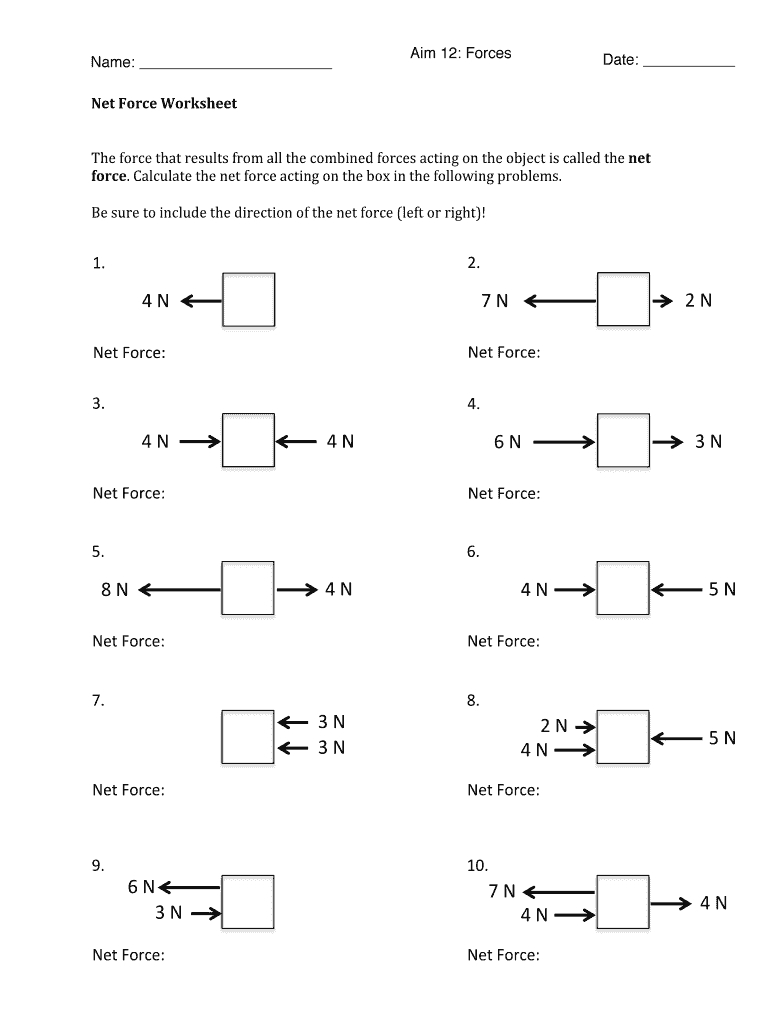Imagine a world without motion. No cars rushing down the highway, no birds soaring through the sky, no planets orbiting the sun. It’s a world devoid of life and energy, a world frozen in time. But the reality we experience is bustling with movement—from the smallest atom to the grandest galaxies, everything is in constant motion. And at the heart of this motion lies a fundamental concept: force.

Image: davida.davivienda.com
Force, in essence, is the push or pull that causes an object to change its motion. This change can be in the form of speed, direction, or both. And acceleration, the rate of change of velocity, is the direct consequence of force. Understanding the relationship between force and acceleration is crucial, especially when it comes to understanding the mechanics of our world. This is where practice worksheets on net force and acceleration come in. These invaluable tools provide a hands-on experience to solidify your understanding of this fascinating and fundamental concept in physics.
Diving into the Dynamics of Motion: Net Force and Acceleration
The concept of net force is the foundation of our exploration into motion. It represents the overall force acting on an object, taking into account all forces acting upon it. Imagine a tug-of-war. The net force is the difference between the forces exerted by each team. If the two teams are perfectly balanced, the net force is zero, and the rope doesn’t move. But if one team pulls harder, the rope moves in their direction, indicating a non-zero net force.
But what does net force have to do with acceleration? Well, the answer lies in Newton’s Second Law of Motion, a cornerstone of physics, expressed by the equation:
F = ma
Where:
- F is the net force, measured in Newtons (N)
- m is the mass of the object, measured in kilograms (kg)
- a is the acceleration of the object, measured in meters per second squared (m/s²)
This equation reveals a direct relationship between net force and acceleration. A larger net force means a greater acceleration, and vice versa. Also, it shows that a massive object requires a larger force to achieve the same acceleration as a less massive object.
Unveiling the Power of Practice: Applying Net Force and Acceleration
Now that we’ve delved into the theoretical framework of net force and acceleration, it’s time to put our knowledge into practice. Practice worksheets provide us with a platform to apply these concepts to real-world scenarios. Let’s take a look at some typical examples you might find on a practice worksheet:
-
Scenario 1: Pushing a Box
Imagine you’re pushing a heavy box across the floor. The force you exert on the box is your applied force. However, friction acts against your effort, creating a force in the opposite direction. The net force is the difference between your applied force and frictional force. The larger the net force, the faster the box accelerates. -
Scenario 2: A Car Accelerating
Imagine a car accelerating from rest. The engine provides a driving force propelling the car forward. But air resistance and friction from the tires also oppose the motion. The net force is the difference between the driving force and the forces opposing it. -
Scenario 3: Free Fall
Consider an object falling freely towards the Earth. The only force acting on it is gravity. Gravity exerts a constant downward force, resulting in a constant downward acceleration.
Mastering the Concepts: Tips to Tackle your Practice Worksheet
Practice worksheets can be a bit intimidating, but with the right approach, they can be a stepping stone to mastering the concepts of net force and acceleration.
- Start with the Basics: Make sure you understand the definition of force, acceleration, and net force. It’s essential to have a clear understanding of these fundamental concepts before tackling more complex problems.
- Draw Free-Body Diagrams: Free-body diagrams are a powerful tool for visualizing forces acting on an object. They help you identify all forces involved and their directions.
- Apply Newton’s Laws: Remember Newton’s Second Law of Motion (F = ma) as your guiding principle. It relates net force to acceleration, helping you solve for unknown values.
- Break Down Complex Problems: Complex problems can often be broken down into simpler steps. Identify all forces acting on the object and then apply Newton’s Laws to each force.
- Seek Help: If you encounter difficulties, don’t hesitate to seek help from your teacher, classmates, or online resources. There are countless resources available to guide you through the complexities of force and acceleration.

Image: gambr.co
Practice Worksheet Net Force And Acceleration
From Practice to Mastery: Empowering Your Understanding
By consistently working through practice worksheets and applying the tips outlined above, you’ll not only master the concepts of net force and acceleration but also gain a deeper understanding of how forces affect objects in our everyday world. These worksheets are your stepping stones to mastering the fundamental principles that govern motion, from the simple act of pushing a box to the intricate mechanics of a spacecraft launching into space.
So, grab a pencil and paper, engage with your practice worksheets, and unlock the secrets of the fascinating world of motion! With dedication and practice, you’ll be able to confidently apply these concepts to real-world scenarios and unravel the mysteries of the universe.






